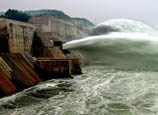
WASHINGTON, June 23 (Xinhua)-- Despite a more resilient U.S. economy, the uncertainty caused by U.S. central bank chief's talk of taking foot off the monetary accelerator leads to greater volatility of capital flows, while emerging market (EM) economies should take flexible measures to cope with the challenges, said economists from the Institute of International Finance (IIF).
WITHIN EXPECTATION
U.S. Federal Reserve policymakers Wednesday painted a brighter picture of U.S. economy on the back of a housing recovery. After a policy meeting, the Fed Chairman Ben Bernanke told reporters that later this year the central bank would start scaling back its massive bond-buying program, the so-called QE3, if the economy improves as expected and may end it by mid-2014 altogether.
"The U.S. economy is showing resilience against strong fiscal headwinds. We expect growth to accelerate gradually in the second half of 2013 and further in 2014," Robin Koepke, an IIF associate economist, said in a recent interview.
"In our view, economic conditions are correctly perceived to have improved sufficiently to warrant contemplating a scaling back of QE and to start a process of normalization. It is important to note that an actual tightening of policy (raising rates) is still some way off," Koepke contended.
Bernanke's announcement was largely in line with market expectation. However, some experts, including James Bullard, president of the Federal Reserve Bank of St. Louis, believed that setting out the QE3 exit timetable now was premature.
"The Fed's expected timing of both the reduction of purchases and the end of QE3 were broadly in line with our expectations and market expectations," Koepke said. The Washington-based IIF has forecasted for a while for the Fed to taper off bond purchases around the fourth quarter 2013, while Bernanke's indication of mid- 2014 as the end of QE3 is a few months later than the IIF's estimate.
FORMIDABLE EXIT TASK
"To the extent that QE3 has lifted U.S. growth, this provides support to the global economy," Felix Huefner, deputy director of Global Macroeconomic Analysis of the IIF, told Xinhua, adding that QE3 also introduces additional uncertainty to global financial markets, as reflected in the recent jittery financial markets.
The news of gradually ending QE3, the monetary stimulus program initiated in September 2012 to bolster lending and economic activity, has roiled global financial markets. U.S. stock market sank after Bernanke's QE3 exit comment before stabilizing Friday. U.S. Treasuries tumbled for three consecutive days, with the yield on the 10-year note hitting its highest levels in about two years.
"It was always clear that exiting from ultra-easy monetary policy would be a formidable communication challenge. In our view, it is too early to assess whether the Fed efforts to this effect have been successful, although it probably would have been beneficial to convey more new information in writing rather than verbally," Koepke said.
Since the onset of the financial crisis, the Fed has kept its short-term interest rate at the historically low level and completed two rounds of quantitative easing programs, known as QE1 and QE2. It is now purchasing longer-term government debt and mortgage-backed securities at a pace of 85 billion U.S. dollars per month, dubbed as the QE3. Experts held that QE helped boost the U.S. housing sector and employment, but it also made it difficult to wean investors off the addiction to the Fed's newly injected liquidity which could lead to asset bubbles.
CAPITAL REVERSAL
"In its early phase, QE3 has meant a weaker dollar and additional capital flows to EM economies. Now that markets focus on the end of QE3, the pendulum has swung to the opposite side," observed Huefner.
First, the uncertainty associated with the exit from QE3 results in greater volatility of capital flows. Second, the exit process is likely to be accompanied by some retrenchment of foreign capital from EM economies, with countries that depend on external financing most at risk, Huefner cautioned.
There has been a retrenchment of foreign capital from EM economies, as indicated by high-frequency data on flows to dedicated EM equity funds in recent months and weaker inflows to EM bond funds. Presumably outflows from EM assets, which are perceived to be relatively risky, should benefit low-risk asset classes such as money-market funds in the United States and other developed economies, Huefner noted.
Emerging market equities posted steep declines in May amid disappointing growth news from China and Brazil, coupled with fears about earlier-than-expected ending of QE in the United States, the IIF's latest Capital Markets Monitor showed.
CHALLENGE FOR CHINA
"As the economic recovery and the end of QE3 in the United States coincide with slowing economic activities in China, we see that some international capital have flown out of China, which put some pressure on Yuan's depreciation. The interbank rate in China spiked at record highs in the past week," said Guo Feng, a senior economist of the Asia Pacific Department of the IIF.
"Apart from the factor that the central bank refrained from injecting more liquidity, it was also attributable to this capital outflows. However, the impact should be smaller than other EM economies, given China's capital controls and structural surplus on the balance of payments," noted Guo, adding that China's central bank should be more flexible in accommodating these changes.
Global economic growth has been led mainly by EM economies in recent years. However, they have been showing signs of slowing lately. The main risk in the United States is a "disorderly exit" of easy monetary policy by the Fed. Slowing economic growth trends in China and India would end soon, but regaining momentum will prove difficult, the IIF noted in a recent Global Economic Monitor report.
















 Childhood in an isolated sterile room
Childhood in an isolated sterile room


![]()
